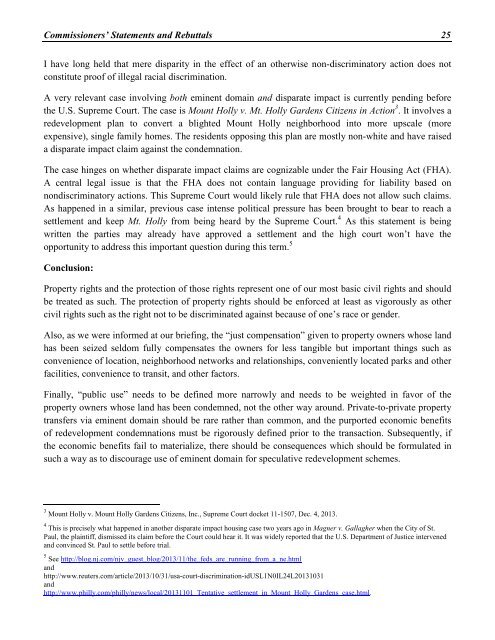Commissioners’ Statements and Rebuttals 25I have long held that mere disparity in the effect of an otherwise non-discriminatory action does notconstitute proof of illegal racial discrimination.A very relevant case involving both eminent domain and disparate impact is currently pending beforethe U.S. Supreme Court. The case is Mount Holly v. Mt. Holly Gardens Citizens in Action 3 . It involves aredevelopment plan to convert a blighted Mount Holly neighborhood into more upscale (moreexpensive), single family homes. The residents opposing this plan are mostly non-white and have raiseda disparate impact claim against the condemnation.The case hinges on whether disparate impact claims are cognizable under the Fair Housing Act (FHA).A central legal issue is that the FHA does not contain language providing for liability based onnondiscriminatory actions. This Supreme Court would likely rule that FHA does not allow such claims.As happened in a similar, previous case intense political pressure has been brought to bear to reach asettlement and keep Mt. Holly from being heard by the Supreme Court. 4 As this statement is beingwritten the parties may already have approved a settlement and the high court won’t have theopportunity to address this important question during this term. 5Conclusion:Property rights and the protection of those rights represent one of our most basic civil rights and shouldbe treated as such. The protection of property rights should be enforced at least as vigorously as othercivil rights such as the right not to be discriminated against because of one’s race or gender.Also, as we were informed at our briefing, the “just compensation” given to property owners whose landhas been seized seldom fully compensates the owners for less tangible but important things such asconvenience of location, neighborhood networks and relationships, conveniently located parks and otherfacilities, convenience to transit, and other factors.Finally, “public use” needs to be defined more narrowly and needs to be weighted in favor of theproperty owners whose land has been condemned, not the other way around. Private-to-private propertytransfers via eminent domain should be rare rather than common, and the purported economic benefitsof redevelopment condemnations must be rigorously defined prior to the transaction. Subsequently, ifthe economic benefits fail to materialize, there should be consequences which should be formulated insuch a way as to discourage use of eminent domain for speculative redevelopment schemes.3 Mount Holly v. Mount Holly Gardens Citizens, Inc., Supreme Court docket 11-1507, Dec. 4, 2013.4 This is precisely what happened in another disparate impact housing case two years ago in Magner v. Gallagher when the City of St.Paul, the plaintiff, dismissed its claim before the Court could hear it. It was widely reported that the U.S. Department of Justice intervenedand convinced St. Paul to settle before trial.5 See http://blog.nj.com/njv_guest_blog/2013/11/the_feds_are_running_from_a_ne.htmlandhttp://www.reuters.com/article/2013/10/31/usa-court-discrimination-idUSL1N0IL24L20131031andhttp://www.philly.com/philly/news/local/20131101_Tentative_settlement_in_Mount_Holly_Gardens_case.html.
26 The Civil Rights Implications of <strong>Eminent</strong> <strong>Domain</strong> AbuseU.S. Commission on Civil Rights Statement for“The Civil Rights Implications of <strong>Eminent</strong> <strong>Domain</strong> Abuse”Commissioner Roberta AchtenbergNovember 9, 2013Examining government’s exercise of the Takings Clause of the Fifth Amendment to the United StatesConstitution is neither simple nor without controversy. The <strong>Report</strong> and the Commission’s full record inthis matter raise two issues of particular concern. Both the lack of recent data and the definition of the“just compensation” due in exchange for government’s exercise of eminent domain powers meritcomment.I. Lack of DataThe Commission’s record does not contain information from recent decades about the incidence andseriousness of disparate impact of eminent domain takings upon the classes of people within theCommission’s jurisdiction. 1I agree with Commissioner Kladney, as he writes in his individual Statement, that the Commission has“not seen a satisfactory case presented that present-day uses of eminent domain amount todiscrimination or denial of equal protection on the basis of race or ethnicity [citing 42 USC 1975a(a)].” 2I questioned both the lack of the most pertinent types of data and the absence of recent data during theAugust 12, 2011 briefing. 3The federal government should ensure the development of current statistics regarding the exercise ofFifth Amendment eminent domain powers and what, if any impact (disparate or otherwise) there hasbeen on racial and ethnic minority communities. The government should achieve this goal by fundingresearch into the scope and impact of recent exercises of eminent domain power through HUD, othergovernment agencies, and/or grants to colleges, universities and private research firms. The government1 This comment is not to be interpreted as criticism of the Commission staff who developed the record and created the<strong>Report</strong>. Such data, in fact, may not exist. See, e.g., United State Government Accountability Office, <strong>Eminent</strong> <strong>Domain</strong>:Information About Its Uses and Effect on Property Owners and Communities is Limited, GAO-07-28, November 2006,available at http://www.gao.gov/new.items/d0728.pdf.2 Kladney, Dave, Statement on <strong>Eminent</strong> <strong>Domain</strong>, November 2013, appended to this <strong>Report</strong>.3 United States Commission on Civil Rights, Briefing Transcript, August 12, 2011, p. 83, l. 10, available athttp://www.usccr.gov/calendar/trnscrpt/08-12-11ccr1.pdf:COMMISSIONER ACHTENBERG: I want to direct this question to Professor Byrne, if I might. My concernin reading the materials has been that the data, at least as far as I can tell, is questionable in terms of thestatistics that are available to us about what has happened, let's say, since 1980 or 1990 or in the most recentdecade past in terms of the allegations that it is clearly a disparate impact that is being felt as a result of eminentdomain on minorities and other disempowered communities. I'm wondering, am I missing something or is thedata as scanty as our current record makes it appear?MR. BYRNE: I think there is a big problem with a lack of empirical study of the employment of eminentdomain, certainly, as you say, in the last two decades or so, done to rigorous social science standards. We reallydon't know very much about the incidence and who is affected by it. And so I think that would be an enormousbenefit and I think something that is agreed across the political spectrum that a better understanding of whatactually occurs would be helpful.


